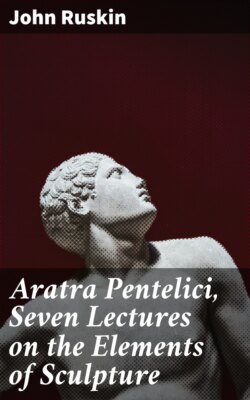Aratra Pentelici, Seven Lectures on the Elements of Sculpture

Реклама. ООО «ЛитРес», ИНН: 7719571260.
Оглавление
John Ruskin. Aratra Pentelici, Seven Lectures on the Elements of Sculpture
Aratra Pentelici, Seven Lectures on the Elements of Sculpture
Table of Contents
LIST OF PLATES
PREFACE
FOOTNOTES:
ARATRA PENTELICI
LECTURE I
OF THE DIVISION OF ARTS
November, 1870
FOOTNOTES:
LECTURE II
IDOLATRY
November, 1870
FOOTNOTES:
LECTURE III
IMAGINATION
November, 1870
FOOTNOTES:
LECTURE IV
LIKENESS
November, 1870
FOOTNOTES:
LECTURE V
STRUCTURE
December, 1870
FOOTNOTES:
LECTURE VI
THE SCHOOL OF ATHENS
December, 1870
FOOTNOTES:
LECTURE VII
THE RELATION BETWEEN MICHAEL ANGELO AND TINTORET.[41]
FOOTNOTES:
Отрывок из книги
John Ruskin
Given before the University of Oxford in Michaelmas Term, 1870
.....
2. In general, the three great, or fine, Arts of Painting, Sculpture, and Architecture, are thought of as distinct from the lower and more mechanical formative arts, such as carpentry or pottery. But we cannot, either verbally, or with any practical advantage, admit such classification. How are we to distinguish painting on canvas from painting on china?—or painting on china from painting on glass?—or painting on glass from infusion of color into any vitreous substance, such as enamel?—or the infusion of color into glass and enamel from the infusion of color into wool or silk, and weaving of pictures in tapestry, or patterns in dress? You will find that although, in ultimately accurate use of the word, painting must be held to mean only the laying of a pigment on a surface with a soft instrument; yet, in broad comparison of the functions of Art, we must conceive of one and the same great artistic faculty, as governing every mode of disposing colors in a permanent relation on, or in, a solid substance; whether it be by tinting canvas, or dyeing stuffs; inlaying metals with fused flint, or coating walls with colored stone.
3. Similarly, the word 'Sculpture,'—though in ultimate accuracy it is to be limited to the development of form in hard substances by cutting away portions of their mass—in broad definition, must be held to signify the reduction of any shapeless mass of solid matter into an intended shape, whatever the consistence of the substance, or nature of the instrument employed; whether we carve a granite mountain, or a piece of box-wood, and whether we use, for our forming instrument, ax, or hammer, or chisel, or our own hands, or water to soften, or fire to fuse;—whenever and however we bring a shapeless thing into shape, we do so under the laws of the one great art of Sculpture.
.....